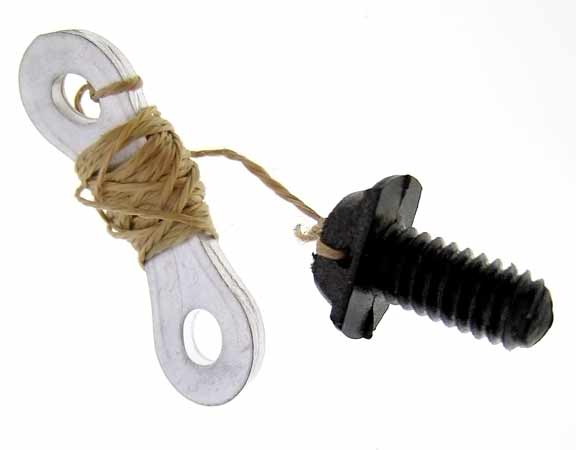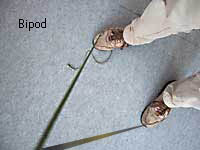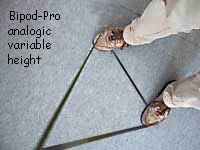




The string will of course not totally replace a
real tripod. But it can give you just that extra stop. This is the luxury
model. - Thanks John for modifying the 1/4 bolt. The basic model is a
simple piece of string with just a loop at each end. Put one loop around
your camera and put your foot in the other. If you pull it tight, you
win up to three stops.
Cheaper than IS and so low-tech that it exists almost as long as photography
itself.
Now I think of it: did anyone ever try to shoot a gun with this as a stabilizer?
The one on the right is the one I always have in my bag. Even with a 300mm
it can give me 2 stops extra.That may just save my day.
Dutch star photojournalist Theo van Houts once used a contraption
like this to capture a candid shot of the Nobel Prize ceremony in Stockholm.
(He did not invent it, as the article in Dutch suggests.)
Feb
2008
This is the latest version of my string tripod:

American viewers may recognise the black screw: it is a retaining screw
for US license plates. Really good ones are nylon. Cheap ones are just
cheap plastic. Sometimes you get them for free. I drilled a tiny hole
in the head, which I sanded the sides off first to get a better grip.
Now I can turn it with two fingers. It is hardly possible to screw it
in too tight because of the really small size of the grip. The cord is
kevlar and the aluminum bean is from my tent. It is easy tro see why this
is better than a washer. The whole thing weighs about 3 grammes which
is 0.1 oz. The length of the bean is 1.5 inch or 37mm.
I recently started experimenting with new configurations and the results
really look promising.
Watch this space ;-)
Some
time ago
Ernesto Andrade
sent me an e-mail with two illustrations in wich he altered my picture.
Have a look: it's brilliant! It felt as if I had a leg missing - or even
two ;-) Hilarious!
Still a good idea! Any triangle is a very stable construction in nature.
This is the story of Theo van Houts as written (in dutch) by Dirk Kuin for Camera Magazine:Inverted Tripod
Also an invention by Theo Van Houts is the inverted or negative tripod. Another tale. He is off to Sweden a lot. For one he speaks the language. At one time he goes to Stockholm to cover the awarding of the Nobel Prize in literature to Garcia Marquez. He knew that there always was a designated photographers area just next to the main stage.
"Anytime you see a picture of the Awarding Ceremony, it's from the side: both the king and the recipient are in profile. No wonder, because you are not allowed to be anywhere else [as a photographer]."
True to himself he did not give in easily. He schemed and networked and made contact with -not the members of the flagger troupe this time [yet another tale -ww] - but with the members of the choir that usually sang on the Ceremony. They have a nice place on center stage and have a commanding view of both the actual ceremony, the guests and the rest of the hall. Van Houts rented a morning coat and disguised as a choir member took front row. Hidden in the coat's inside pocket the Minox we mentioned before. Small and above all almost noiseless. Attached to his belt a shock cord of about 15 inch. At the moment supreme he pulls the tiny camera from his pocket ("I pushed the 160 iso film to 320") attaches the cord ("to get enough counter force, in order to hold it reasonably still for a longer shutter speed - hence the negative tripod") and made a gorgeous panoramic overview with his moderate wide angle.
The awarding of the Prize, the Royal entourage, laureates, the public and - last but not least - somewhere below the stage a tangle heaving and toiling colleagues. He caught everything and everybody.
"I think it was a shutter speed of 1/15 or even 1/8. At full aperture. Because of my shock cord it was a picture that could be well enlarged. Later I went back in Hamstad where it hung prominently at my show. It was the first time the Swedes could see what the Ceremony really looked like."Dirk Kuin in: Camera Magazine 02-96
- translation mine -ww -

